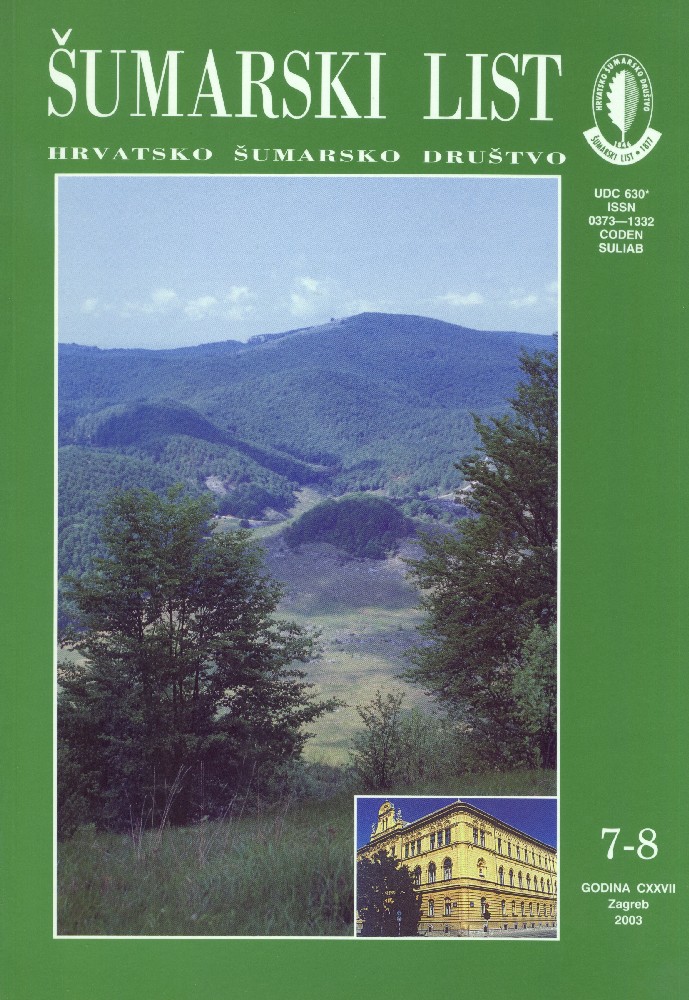
broj: 7-8/2003
pdf (23,8 MB) |
|
||||||||||||||
| IZVORNI ZNANSTVENI ČLANCI | ||
| Sabo, A. | UDK 630* 462 (001) | |
| Damaging Trees in Timber Skidding by TIMBERJACK 240C in Seleciton Forest Stands pdf HR EN | 335 | |
| Ballian, D. | UDK 630* 165 (001) | |
| assessment of genetic variability of silver fir (Abies alba mill.) with cpDNA analysis in the part of natural populations of Bosnia and Herzegovina and Croatia pdf HR EN | 347 | |
| PRETHODNO PRIOPĆENJE | ||
| Vučetić, V., Vučetić, M. | UDK 630* 111 + 181.8 | |
| Phenological Characteristics in the Area of Zavižan pdf HR EN | 359 | |
| PREGLEDNI ČLANCI | ||
| Ištvanić, J. | UDK 630* 822 (Fagus sylvatica L.) | |
| Beech (Fagus Sylvatica L.) Sawmill Processing in Croatia pdf HR EN | 373 | |
| Zelić, J., Pauča, B. | UDK 630* 569 | |
| The Contribution to Determining Basic Normals for Mixed Selection Forest of Beech and Silver Fir in Pannonian Mountains pdf HR EN | 389 | |
| Summary: In the past, mixed stands of beech and fir on Papuk (Abieti-Fagetum panonicum Rauš 1969), were managed as regular high stands, while natural regeneration was done with the shelterwood cutting method. Biological and ecological properties of beech and fir indicate the possibility of selection management. Such stands are ecologically more stable and better capable of utilising soil and climatic characteristics. The high ecological stability and biological properties of beech and fir selections stands result in an optimal production of stem wood and in balanced management. Of all biometrical management characteristics, the following are of utmost importance: dominant tree heights, tariff series, crop maturity dimension and current annual stand increment. Compartment 56a, Management Unit "Zapadni Papuk II" covering an area of 15.10 ha, with a species mix of 53 % of beech and 47 % of fir was taken as an example of management with a mixed stand of beech and fir on Papuk. The distribution of beech and fir trees by hectare and diameter classes is shown in Table 1 and Graph 1. The dominant heights of mixed stand of beech and fir were defined using the "Swedish method" for mean breast diameters increased for standard deviation (ddom = ds + s). The crop maturity dimension was determined for 60 cm of breast diameter (German diameter degree 57.5 cm). The mean breast diameter of beech in a stand is 29.97 cm with standard deviation of 16.10 cm, while that of fir is 42.65 with standard deviation of 17.87. The stand height curves of beech and fir in Compartment 56a were equalised with exponential functions (Graph 2, a): h = 38,6264 e - 14,3356 / d + 1,3, for beech h = 37,2016 e - 13,3950 / d + 1,3, for silver fir The geometric progression coefficient (q) of the number of trees from lower to higher diameter degrees is higher than 1 (q > 1) and is called Liocourt´s progression coefficient. In the given mixed stand of beech and fir the geometric progression coefficient for beech was 1.4693 according to Collet and that for fir was 1.3651 according to Susmel. The normal tree number (N), the normal basal area (G) and the normal volume (V) per hectare were calculated using the stated geometric progression coefficients (q) for beech and fir (Table 2). The dominant height (hdom) for beech is 29.60 m and for fir 31.12 m. Normal tree number series for beech and fir in Compartment 56a were calculated using Mayer´s function of tree number density per hectare: N = 385,2748 e - 0,7615 d , for beech … 460 trees N = 334,4691 e - 0,6244 d , for silver fir … 546 trees The tariff volume series were constructed according to Špiranec´s functions for beech and fir volume and Mihajlov´s height curves: v = 0,00003468 d 2,024425 h 1,032212 , for beech v = 0,00005015 d 1,877477 h 1,054306 , for silver fir Local tariffs are given in Tables 3, 3a and Graph 3. The normal model for beech was determined at 285.72 m3/ha and for fir at 380.33 m3/ha. The normal model for a mixed stand of beech (53 %) and fir (47 %) was determined at 330.18 m3/ha (Table 3, 3a, Graph 4). The transition time for a mixed stand of beech and fir was determined on the basis of breast diameter, which decreases with an increase in breast diameter. The transition time for the stand in Compartment 56a was equalised with exponential functions: T = 2,3789 d - 0,8218 , for beech T = 2,4922 d - 0,8509 , for silver fir Equalised transition times for beech and fir in Compartment 56a, MU "Zapadni Papuk II", are given in Graph 5. The percentage of current annual volume increment for beech and fir was equalised with functions: pi = 7,525 - 2,996 log d, for beech, pi = 5,955 - 2,235 log d, for silver fir Equalised percentage of current annual fir increment is given in Graph 6. A cutting cycle (10 years) of 90.00 m3/ha can be calculated on the basis of the normal model for a mixed stand of beech and fir of 330.18 m3/ha, current volume transition of 91.10 m3/ha and current volume stand increment (10 years) of 89.90 m3/ha. (Table 4) The difference between the normal volume per hectare before cutting (M) and after cutting (m) is determined on the basis of a 10-year increment or volume transition and is equal to the felling cycle (E = M - m). Liocourt´s distribution, tariffs, transition time, annual volume transition, 10-year volume increment, normal stand volume before and after cutting per hectare. Key words: Mean breast diameter; dominant height; Swedish method; normal model | ||


